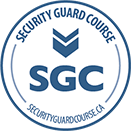What constitutes a good course? How do you know if it will stand up in court if challenged?
In order to answer this question we need to look at the context first before the content details. The term “Use of Force” means a lot of different things to different people. In the context of Security Guard applications, the term comes from policing originally. A number of functions, such as investigations, arrest and even keeping the peace are either identical in their application or similar but done according to different legislation and guidelines.
This said, too many times, guard company use of force instructors tend to either be ex-cops, current serving ones, or were taught by them. Worse, unqualified martial arts instructors are used. Both can be dangerous from a liability standpoint if the program is not adjusted to suit the context of a security guard and also made specific to the application of their duties. (Many law suits have stemmed from guards being taught generic materials and not provided with specific context on how to apply it. See below under Judgment and Decision making content.)
Use of Force, as a topic or course heading is broken down by topic area as follows:
- Academics:
Includes Charter of Rights, Criminal Code: common offenses, C.D.S.A. for information only, arrest, use of force and case law, Trespass and Liquor legislation, Evidence Act: Provincial and Canada Evidence Act, Provincial Occupiers Liability Act and any other applicable legislation that could impact the guard’s actions on a specific job site.
- Communications Skills:
This is a broad term but normally includes:
“Tactical Communications” or similar. This comes from the policing world and has come under some scrutiny due to the fact that, although the techniques are valid, they are not very effective on people who are not lucid, suffer any form of cognitive impairment, or the mentally ill.
Verbal De-escalation Skills: Understanding forms of cognitive impairment, mental illnesses, Emotional Intelligence and how emotions drive behavior.
Mental illness is an area of study within use of force that is a topic unto itself. “Persons in Crisis” as they are now called, is a highly contentious topic that is arguably the most likely to attract civil litigation when there are encounters that don’t end well. One simply has to look at the police in the media to see what is currently happening there.
- Proactive Violence Prevention:
This is a short module taught as part of Guard Safety. Content includes policy review, proactive planning of predictable incidents and table top scenarios.
- Guard Safety and Situational Awareness:
This must be made specific to where the guards are deployed and the everyday situations they face.
- Soft Empty Hand Skills:
Joint manipulations and other techniques not necessarily designed to cause pain but rather to take away another person’s ability to strike/ overpower you and displace their balance. These include:
- disengagement techniques or defenses against common grabs that do NOT require strikes or kicks.
- wrist-locks, arm bars, and other skills to facilitate escorts or evictions of low end resistant persons.
- Hard Empty Hand Skills:
Punches, kicks, elbow or knee strikes. These are designed to specifically cause pain or “motor dysfunctions” in pressure points on the body.
- Handcuffing Skills:
There are at least twelve (12) different ways to passively handcuff a person using the standard issue ASP, Peerless or S & W handcuffs. None of which are wrong if done without causing injuries to the prisoner. They go by many names such as “speed cuffing,” “tactical handcuffing,” etc, but in the end, no one technique is any faster necessarily than another. It all depends on the competency level of the user. (By the way, ANYONE in Canada can buy and use handcuffs. Guards are regulated by legislation for use as P.P.E. tools on the job, which is why guards are not permitted to own their own handcuffs and they must be issued by the employer.)
There are two distinct Handcuffing skill sets: Passive and Active.
Passive handcuffing is a very simple process easily learned by watching or following step by step instructions with pictures. There is no resistance to overcome, and given that guards are not police officers, if there is any resistance they should disengage rather than force a higher level confrontation and risk injuries. (This comes from the Supreme Court of Canada in case law.)
Active Handcuffing is when there is a level of resistance beyond the passive level. Typically subjects are “grounded” or forced against solid objects, then a joint manipulation technique is used to control them until the handcuffs are forcibly applied. This takes practice and must be learned in class. Aside from being highly likely to cause injuries to people and guards if done incorrectly, it can lead to asphyxiation and even death in some cases.
- Post Arrest Search and Prisoner Care:
This is also broken down into Passive vs Active Search and is based, like handcuffing, on the behavior of the prisoner. There is also a heavy emphasis required on the legal aspects of search as they relate to Section 8 of the Charter, case law and rules of evidence.
Passive search is a simple step by step process easily learned by watching videos and following step by step instructions with pictures. As with any subject, there are variations that are taught from “crimp searches,” to “pat downs” to more modern searches where a search tool is used rather than risking injuries from hidden sharps.
Active search is a skill set to be learned hands on in a classroom. It involves the “pinning” of a prisoner in order to forcibly search them for weapons. The risks of injury or asphyxia are high if done improperly and therefore best left to a highly skilled classroom based instructor to teach.
- Baton Skills:
While this is becoming less and less utilized today because of the “trial by social media” and public perceptions that can ruin a company and lives, it relies totally on pain compliance to be effective. Batons offer NO level of control whatsoever, the same as Hard Empty Hand Skills and are therefore not recommended or condoned by the courts for most security guard applications.
As a supplemental P.P.E. “tool” there are arguments that can be made, but they are site specific and based on many factors. This said, legislation in most Provinces do permit guards to carry batons on the job however the requirements for training are far from standardized.
There are still several different types of batons in use today ranging from the most common ASP expandable to the old school PR24 Manadnock sidehandle version. Again, none are any better than the other, it always comes down to user competence.
- Judgment and Decision Making:
This includes the articulation of incidents, the academic study of case law as to what is or isn’t “justified” at the end of a specific incident, and how a guard’s decision making process works under stressful situations.
Delivery Methodologies in the 21st Century
Online training has improved leaps and bounds in the past five years or so. Colleges and Universities heavily rely on their online courses and regularly issue “certificates” for courses completed. The pushback initially was twofold; how do you know if the person behind the remote computer is actually the person taking the course AND how do you stop cheating?
Both of these issues have been overcome to the point that the Canadian General Standards Board has approved “distance learning” in order to meet the ISO 9001 standard for training Security Officers for Federal properties and the Provincial governments are now training their own officers this way.
Use of force training is a threefold topic; Academics, the Physical skills or practical application of the learned skills and Judgment and Decision making skills. So what can be done with sufficient due diligence online vs what should, reasonably, be taught in a classroom?
There is no argument that face to face teaching or academics was the best delivery methodology for most subjects, but since the invention of “face time” chats online, this has become a moot point. It is also an expensive proposition compared to online learning and no longer necessary.
Use of Force courses were never intended to be “self-defense” programs. If this is what the employer wants, then get a properly qualified person to come and teach Soft and Hard Empty Hand skills, control techniques, Baton etc. Be forewarned though, the level of due diligence for the application of these skills is very high and it does attract plenty of civil litigation.
Smart employers stay away from pain control or pressure point techniques and stick to empty hand disengagement skills. Hard Empty Hand and Baton skills are rarely used anymore, mostly for legal reasons, not to mention the public’s perception and the difficulty in today’s courts in attempting to justify their use.
The use of unpalatable neck restraint techniques, still taught to security guards in this country unfortunately, are highly controversial to the point they are being made illegal in some parts of North America.
It cannot be overstated, however, that Security Guards ARE NOT COPS, and should not be taught the same skills with the same mentality. “One level higher, force plus one, as much as….” etc are all relics of the past that existed in the police world and are no longer valid today in the security world. (Again, not my words, they are those of the Supreme Court.)
Guards do not have a mandate to make arrests in law and the courts have recommended that they be avoided if possible and force used only as a very last resort when all other efforts have failed.
In a typical two day program covering all of the above topics, about half was dedicated to academics and half to physical skills. Programs were modified to suit new guards with no previous training, vs more advanced classes for “veteran” guards.
Today, we now offer online training and certification in the Use of Force and Passive Handcuffing and Search covering the following topics:
All Use of Force related Academics
Communications: All topics
Passive Handcuffing
Passive Search
Proactive Violence Prevention
Officer Safety and Situational Awareness
Post Arrest Search and Prisoner Care
Judgment and Decision Making
In most security applications, these topics are sufficient for basic duties, cover the required due diligence and raise the level of competence and confidence of the frontline guard. While it can be said that learning a tactile skill like handcuffing online is a bit like learning to ride a bike by reading a book…point taken… it is ultimately the responsibility of the learner and their managers to ensure the level of competence is present before they deploy them. The instructor’s liability ends at the end of the course. If an employer feels they need more due diligence by having an instructor at least remotely watch the application of the cuffs and search before certification, then that is their call. If they are uncomfortable in the “certifying” guards in handcuffing and search components until a hands on session can be done, then simply remove these elements from the certification and only the teach the related academics.
Covid19 has forced security guard employers to seek alternatives to training among other challenges. The migration of Use of Force to online has been broached in the past but never widely accepted until two impacting factors came into play; The high and increasing cost of in class training (Tuition, wages, wages for replacement guards, overtime, turnover rate of guards etc) AND Covid19. Both are now a reality, it’s time to change people.








